- Home
- Deborah Blum
The Ghost Hunters Page 8
The Ghost Hunters Read online
Page 8
Fred Myers was the first to perceive the risk. He’d gone to London to investigate a very pretty new medium, a blond American named Anna Eva Fay, who performed in Davenport Brothers style with a showy cabinet, ghost hands, and mysterious music. Crookes had immediately warned Myers off, saying that he had priority claim on such investigations.
“The lion will not be robbed of his cub,” Myers wrote to Sidgwick, adding, “nor the cub her lion.” Fay visibly appreciated Crookes’s protection, as well she might. The resulting experiments seemed unusually accommodating. The medium asked to work in a darkened room. Crookes, in a reversal of his earlier insistence on light with D. D. Home, agreed to that request. He also quickly announced the tests successful.
There was no doubt, Myers wrote to Sidgwick, that the newcomer was beautiful and charming. He himself found her delightful. He just wasn’t sure she was trustworthy. Myers persuaded Fay to visit Balfour’s home, for just a few little experiments. Actually, he had one in mind—simple immobilization. They tied the medium’s hands to widely separated metal rings, fixed to a board, and then waited for the “spirits” to help her out. The observers waited until it became obvious that nothing was going to happen. When Myers went home that night, he pulled out his journal and drew a fat black line through Fay’s name. Equally irritated, Sidgwick proposed that they begin avoiding professional spiritualists.
It appeared, he said, that paid mediums brought nothing to the enterprise but “persistent and singular frustration.” They could only hope that a professional scientist, like Mr. Crookes, would be as wary. But the Sidgwick group was reaching a new awareness—that in their smug sense of superior intelligence and capabilities, trained scientists did not always see what was obvious to others.
EVEN THE FAMED spiritualist medium D. D. Home now warned that the profession was rife with fraud, to the point that he felt a need to provide some exposure. In particular, Home decried the increasing use of “dark séances,” conducted in a gloom so dense that no one could follow a medium’s actions, a darkness justified by the claim that spirits preferred the shadows. “Light should be the demand of every spiritualist,” wrote Home in a book he completed in 1876. “By no other [tests] are scientific inquirers to be convinced. Where there is darkness there is the possibility of imposture—and the certainty of suspicion.”
Home’s tuberculosis symptoms were creeping back, sending him to the south of France in hopes that a softer climate might prove healing. His days of calling up spirits and floating off the floor were over. Ever a man with a mission, Home had decided on his own last act—to expose and help remove fraud from his profession.
In Lights and Shadows of Spiritualism, written with the help of his longtime lawyer, Home took a fierce stand against not only dark seances but the wide range of conjuring tricks used by his fellow mediums. He went on to explain some of them in detail, including the way to fake “full-form materialization,” the type favored by the unfortunate Newcastle mediums. According to Home, a medium only need conceal fine muslin fabric—the filmy stuff produced in France was a favorite—in her underwear. She could count on the fact that no gentleman would invade a woman’s privacy by searching there. After retiring into her cabinet, the medium could wiggle out of any knots, strip, lay her dark clothes on pillows arranged on her resting couch, and flit out into the room draped in her floating muslins.
For the first time, Crookes was genuinely unhappy with D. D. Home. His wife wrote to the ailing medium, saying she feared his revelations could do further harm to her husband’s reputation: “Of course, it is looked upon as a complete exposure of the whole subject by the biggest imposter of them all,” she wrote, adding that Home’s book was “the best weapon” their enemies could acquire. She and her husband had reason to feel defensive by then; Crookes had become involved with another female medium, moved into another “lion and cub” relationship, this time with one of London’s most artful psychic performers. His reports on Florence Cook were so smitten that the near universal verdict was that she had become his mistress.
Barely in her twenties, Cook was strikingly pretty, with big dark eyes, thick, curly hair, and a curvy body that she liked to emphasize with closely fitted black dresses. Of course, those black garments and matching black boots made her hard to see in the dark, which was where she liked to hold her seances, comfortably ensconced behind the silken curtains of her cabinet. What made Cook noteworthy was that while she was tied up in her cabinet, her “spirit guide” would wander into the room.
Almost all working mediums claimed to need a guide, a spirit to help them navigate the mysterious realms of the other world. Trance mediums called their guides “controls,” giving their trances a rather eerie suggestion of possession. When a medium was in a trance, the control would speak through her or him, summon other spirits, and impart advice to those gathered around. Cook claimed to be able to coax her guide right into the room, fully materialized as a graceful young girl named Katie King, a creature of flowing white robes and charming manners.
Katie King could flirt, eat (cakes), drink (wine), and tuck her plump little hands into William Crookes’s arm. The scientist confessed himself enchanted. He’d taken pictures of the lovely spirit, but “Photography is as inadequate to depict the perfect beauty of Katie’s face, as words are powerless to depict the charm of her manner.”
But Florrie Cook didn’t move in the elevated circles where D. D. Home held his exclusive seances. Until Crookes gave her special status, Cook had been just another pretty street medium. She moved in a circle where violent competition was the rule, and her resentful competitors were quick to bring her back down to their level. Stories spread that Cook was having an affair with Crookes, that he was more lover than scientific observer. One mother-daughter pair of jealous mediums forged letters to confirm the illicit relationship.
Crookes denied the charges vigorously. But he was increasingly aware that his explanations were dismissed and his denials brushed away. It was to D. D. Home that he then confided his sense of betrayal, writing a letter that overflowed with hurt pride and genuine hurt as well. As Crookes told Home, “were it not for the regard we bear to you, I would cut the spiritual connection, and never read, speak or think of the subject again.” He had decided not to hunt for another Home, at least not any time soon. Instead, Crookes determined that it was time for him to return to the safer—and definitely saner—world of mainstream science.
EVEN AS CROOKES WITHDREW, though, another conventional scientist, the first physicist to really embrace the idea of occult studies, made an unexpected foray into supernatural research.
William Fletcher Barrett had been educated under John Tyndall, that outspoken opponent of all things spiritual. Barrett had worked in Tyndall’s laboratory for four years before taking a position as professor of physics at Dublin’s Royal College of Science.
A big, tousle-haired bear of a man with a dramatic flair for telling a tale, Barrett may have lacked his mentor’s dazzling genius, but he was a thorough and conscientious researcher who had assigned himself the task of sifting through the electromagnetic properties of iron alloys. Barrett had little interest in the supernatural, although he had earlier—in 1871—corresponded with William Crookes, who was then seeking a theory to explain his results with D. D. Home. “If you can help me to form anything like a physical theory, I should be delighted,” Crookes wrote. Barrett, not particularly drawn to spiritualism, had casually written back to propose that hallucination might be a good answer.
A few years later, though, Barrett would change his mind about that hasty reply. He enjoyed a habit of spending part of each summer vacationing with friends in the countryside south of Dublin. His friends were fascinated by hypnotism—also called mesmerism, due to the early influence of Anton Mesmer on the field—and they occasionally conducted experiments with local villagers. These exercises amused Barrett; he held to the earlier idea that these so-called trances were some form of hallucination. It was only in 1875 that the tests, car
ried out with a group of village girls, caught his attention.
When hypnotized, one of the girls seemed sometimes to make an uncanny connection to another person’s thoughts. Barrett, suspecting trickery, some kind of signaling, decided to lend a scientist’s hand. He blindfolded the girl and then asked his friend to perform a selected series of interactions with the hypnotized girl.
As Barrett later wrote, “If [the friend] placed his hand over the lighted lamp, the girl instantly withdrew hers, as if in pain. If he tasted salt or sugar, corresponding expressions of dislike and approval were indicated by the girl.” Occasionally, the girl seemed also to inexplicably know some of what Barrett was pondering as he ran the experiments. Not precisely, but close enough, a “more or less distorted reflection of my own thought.”
When Barrett returned to his university, he conducted some follow-up experiments and drafted a paper on his research. He gave it the studiedly neutral title “On Some Phenomena Associated with Abnormal Conditions of Mind.” He then submitted his paper for presentation at the 1876 meeting of the British Association of Science, the body that, headed by Tyndall, had urged all spiritualists, as well as traditional religious leaders, to step aside for the edicts of science. The association reviewers weren’t fooled by the title; they knew crackpot science when they read it. Barrett’s paper was rejected first by the biology division and then by the anthropology division and was scheduled for the trash pile when the chairman of the anthropology subsection, Alfred Russel Wallace, rescued it and used his position as chair to force it into the program.
In his paper, Barrett wrote with the caution of a man inching his way across thin ice. He tentatively proposed that at some unconscious level, it might be possible for a person to tap into another’s thoughts or feelings. He speculated that this might occur in a “community of sensation,” and suggested that further investigation might be warranted.
Barrett stood firm only in his conclusion, which sounded a warning note. If he and his researchers rejected phenomena simply because they seemed strange and so far inexplicable, scientists might end up “laying ourselves open to that same spirit of bigotry that persecuted Galileo.”
Not unexpectedly, Wallace joined him in urging further investigation. More surprisingly, at least to the members of the association, the decidedly science-centered Lord Rayleigh also urged further investigation. “My opportunities have not been so good as those enjoyed by Professor Barrett,” Rayleigh explained. “But I have seen enough to convince me that those are wrong who wish to prevent investigation.” Rayleigh might be unconvinced as yet himself, but he wasn’t afraid to chastise his peers for taking a political rather than a scientific stance.
Tyndall was flat-out furious. It was outrageous that one of his students had gone so wrong and that the association, under his command, appeared to endorse this preposterous minority view. He wanted it made clear that no real researcher believed that there was anything, anything at all, in thought transference or “mentalism,” as self-anointed psychics loved to call it. The scientific association’s response came like a thrown missile: an investigation was out of the question. Further, Barrett’s would be the one conference paper that would not be published in the meeting proceedings.
Unfortunately, from that perspective, Barrett’s study could not be kept completely secret. The initial report received plenty of newspaper coverage and excited interest from readers, as well as rare approval from Sidgwick and even an offer of money from Fred Myers. “Remember that if in any way your experiments can be helped by money, I shall be positively glad to know of what I consider so good a way of spending some,” Myers wrote.
Still, Barrett was now also angry. Although he had known that his report would stir controversy, Barrett had not expected to be treated so shabbily. He was Tyndall trained; he was thirty-two years old; he had spent more than a decade following the rules of science to the letter. He knew his study to be worthy. His experiments were careful, his arguments rational. Barrett was irate enough not to step meekly back into line. He decided to continue his investigations, with or without the support of mainstream science. And he chose not to tiptoe around the results this time. He chose to make his next study as public as possible.
Barrett fired his first salvo by writing a letter to the Times of London in September 1876, announcing that he was interested in mind-reading and therefore seeking letters from people who had witnessed a good illustration of “the willing game.”
He described the response as “a flood of replies from all over England.” His university office was buried in banks of white envelopes. Letters formed drifts across his home office like the remnants of a winter storm. The postman literally staggered to his door, dumping resentment and pounds of mail in equal measure.
Barrett’s fellow scientists might not be interested in his new research project. But it seemed that just about everyone else was—or that a surprising number of British residents liked to play the willing game.
The willing game was a dinner party entertainment with a mind-reading twist—and a clever title. The rules were simple: after guests had gathered, one person would be chosen to leave the parlor. Once he or she had left, a task would be decided on: perhaps picking an iris out of a bouquet, maybe selecting a certain book from a shelf, kissing a wife, straightening a husband’s tie, finding a hidden object.
Ideally, the chosen person would be “willed” into the action chosen, following directions sent mentally by others. Often, he or she would be blindfolded before reentering the room, guided by another player. Sometimes the guide would place a hand lightly against the seeker’s shoulder or forehead, using touch as an additional aid in “willing” a job to be done.
To scornful physiologists, this was simply another version of table turning, easily explained by applying Faraday’s golden rule of unrealized motion or subtle cuing. It was all “unconscious muscular action on one side, unconscious muscular discernment on the other.” The guide was probably giving inadvertent signals, they said, tightening fingers in response to one move, pushing a little in response to another. The blindfolded follower was undoubtedly doing just that—following.
The willing game was an invitation to cheat, scientists said. It only required two confederates, agreed to work together in fooling the rest of the room. It was no wonder that so many wives were successfully kissed, irises plucked, books correctly selected off shelves.
When would the gullible public learn that it was participating in another variation on planchettes, tilting tables, and spirit cabinets? At least the willing game, unlike the tricks of professional, paid mediums, was played in private, with no money at stake.
In the case of slate writing—another new technique for supposedly communicating with the dead—one eminent British zoologist, Ray Lankester, became so outraged by the gall, the effrontery of it, that he decided to expose its leading practitioner—just as publicly as Barrett had with his mind-reading investigation.
The medium in question was one more American, styling himself as the new D. D. Home. As such, Henry Slade cultivated an ethereal look. A London newspaper described him as possessing a “dreamy mystical face, regular features, eyes luminous with expression, a rather sad smile and a certain melancholy grace of manner.” Like Home, he could also make tables levitate and ghostly hands float through the air.
But his claim to fame was slate writing, described as a talent for inducing “spirits” to write directly onto slates, without any need for a planchettelike apparatus. Slade used small rectangular slates, or chalkboards, much like the kind that children use for lessons in schools. At its most basic, slate writing involved holding a blank slate and chalk pencil under a table. The medium and the visitor would wait until they could hear the scratchy sounds of writing, the pencil apparently propelled by a mysterious power. When the slate was brought up for examination, messages would be scrawled across the formerly pristine surface.
Lankester wasted no time putting this nonsense to bed. He met Slade, sat
down at the appointed table, watched only for the writing materials to be placed beneath it, and then yanked the slate back out, not bothering to wait for any sounds of scribbling. As Lankester wrote to the Times, the slate in his hand was already fully inscribed with a written message. In other words, he explained to the newspaper’s readers, the medium had switched the first blank slate for one already containing a “spirit” message.
Lankester wasn’t content with merely embarrassing the visiting performer ; he insisted that Slade be prosecuted as a con artist. In the resulting October 1876 trial, Lankester also insisted that science dominate the proceedings, that the judge make a decision based only on “inferences to be drawn from the known course of nature.”
Despite a few eloquent defenders—including Alfred Russel Wallace—Slade was convicted and sentenced to hard labor. To Lankester’s disgust, however, the sentence was overturned on a technicality, and Slade fled to the Continent. Nevertheless, the scientist thought he’d achieved his goal to make it clear that researchers would no longer tolerate this endless series of murky and mystical claims. He hoped that the subject would be dropped, preferably forever, and that scientific discussions would no longer be “degraded by talk of spiritualism.”
IN THE YEAR 1876, the year of Slade’s trial, the year that introduced the player piano and the National Baseball League, the year the telephone was invented in America and the internal combustion engine in Germany, the year William James was named an assistant professor of physiology at Harvard, the year of Henry and Nora Sidgwick’s marriage, Fred Myers’s attention, heart and soul, belonged to a woman he could not have.
For Myers the winds of change blew dark, blew stormy, for 1876 was also the year that the woman whom Myers loved committed suicide.

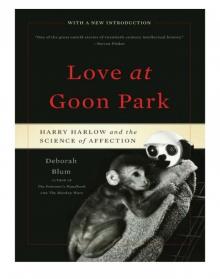 Love at Goon Park: Harry Harlow and the Science of Affection
Love at Goon Park: Harry Harlow and the Science of Affection The Poison Squad
The Poison Squad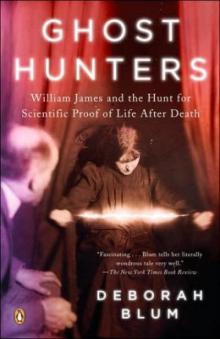 Ghost Hunters: The Victorians and the Hunt for Proof of Life After Death
Ghost Hunters: The Victorians and the Hunt for Proof of Life After Death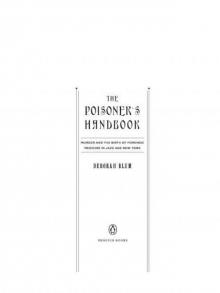 The Poisoner's Handbook
The Poisoner's Handbook Angel Killer
Angel Killer The Best American Science and Nature Writing 2014
The Best American Science and Nature Writing 2014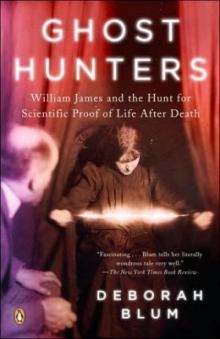 The Ghost Hunters
The Ghost Hunters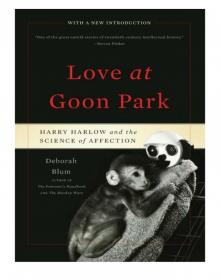 Love at Goon Park
Love at Goon Park